- Submissions

Full Text
COJ Biomedical Science & Research
Holistic Prophylactic Host Factors for Cancer Prevention Program
Tsuneo Kobayashi*
International Cancer Detection and Prevention Center, Japan
*Corresponding author: Tsuneo Kobayashi, International Cancer Detection and Prevention Center, Japan
Submission: February 26, 2020; Published: March 09, 2020
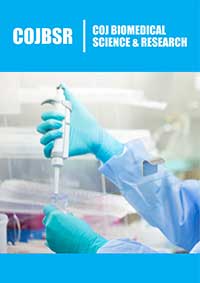
Volume1 Issue1March 2020
Abstract
Background: To date, cancer chemoprevention in separate organs has been reported. In this study, chemo-preventive drugs and knowledge for preventing cancer in all organs were summarized and this methods for preventing recurrence in the host side factors were evaluated. There have been several reports on the relationship between Vitamins and cancer, including those reported by Muto [1-3] about the relationship between Vitamin A and cancer as well as correlation Vitamin D and cancer reported from USA, and another reported by NCI(USA) about the association between high dose Vitamin C and cancer. It has been elucidated that cancer easily forms in low calcium conditions. Here, I reported the relationship between cyclic AMP and cancer and show that white blood cell counts correlate with immunity. Because cancer proliferate by using glutamine, a combination of Dietary Energy Restriction (DER) with restricted glutamine and 5% animal protein consumption and seven factors was devised as a method to prevent cancer with holistic prophylactic program.
Materials and methods: A combination of seven factors, DER with supplementation of sufficient concentrations of Vitamin A, C, D and calcium, fasting once weekly by consuming only vegetable juice to improve low cyclic AMP concentrations, and intradermal inoculation of BCG vaccine as a measure against low white blood cell count, was comprehensively prescribed. Five patients who had undergone surgery for recurrent cervical cancer, vascular granulomatosis with polyangiitis, advanced lung cancer, breast cancer and postoperative rectal cancer were included in this study. But we have failed on the patient with pancreatic cancer patient. Assessments were performed using Tumor Marker Combination Assay (TMCA). The primary outcomes included improvements in the seven factors resulting from the treatment. Although differentiation inducing treatment was basic therapy, hyperthermia treatment was not administered in this time. In case of inflammatory changes, minomycin, which has antioxidant activity, was added in small amounts, and a special herbal medicine (SA) was used given in case of metastasis.
Result: All five patients were difficult to treat with conventional cancer treatments, however, by applying the knowledge of seven host factors and affiliated antioxidant and differentiation- inducing treatments, the conditions of all five patients improved except one patient.
Conclusion: If improvement measures can be implemented for seven host factors, including DER, improvement in low concentrations of Vitamin A, C, D, Calcium, cyclic AMP and white blood cell counts, the recurrence of cancer can be prevented, and these seven host factors can serve as indicators for cancer prediction and prevention.
Keywords: Vitamin A shortage; Vitamin C shortage; Vitamin D shortage; Low cyclic AMP; Low WBC, Low calcium; 7 prophylactic host factors for cancer prevention program
Introduction
To date, there have been limited reports on chemoprevention by organs. However, cancer can develop anywhere in the body, hence, the prevention of cancer by organs has little significance. In light of this clinical problem, we developed a holistic prophylactic cancer prevention programs to deal with all organ cancers. Incidence of cancer increases with excessive dietary glutamine; hence, cancer can be fundamentally prevented with Dietary Energy Restriction (DER). In order to limit the dietary intake of glutamine and maintain a diet low in AGEs, we gave instruction to discontinue cooking in a microwave. In addition, animal protein was limited to 5%.
The above data are cited from Seyfried T [4] (Figure 1). Because a combination of glutamine and sugar promotes strong cancer growth, it is important to follow a diet with low glutamine content. Therefore, DER is the first measure [5-7]. As a second measure, there was a great deal of data on the relationship between Vitamin A and cancer as reported by Muto [1-3]. Prescribing Vitamin A or maintaining its high concentration through intramuscular injections is considered advisable because not only do cancer patients have a decreased intake of Vitamin A and decreased concentration of Vitamin A-binding protein but these cancerous tissue also destroy Vitamin A. It is also important to know that Vitamin A has differentiation inducing effects. The third measure is the relationship between Vitamin C and cancer. NCI(USA) has reported that high concentrations of Vitamin C are effective in preventing all cancers [8,9]. The human body cannot biosynthesize Vitamin C; therefore, replenishment of a sufficient amount of high dose Vitamin C (Vitamin C in urine should also presented (Fujifilm Wako Pure Drug KK) is required.
Figure 1:

Patient was advised to maintain urinary concentration of Vitamin C in every time over 60mg/dl. The fourth measure is the relationship between Vitamin D and cancer. Vitamin D has been associated with the development of cancer in these days [10-12]. For the fifth measure, we confirmed that low calcium conditions in vitro increase the tendency for cancer development; therefore, adequate amount of Vitamin D and calcium supplementations are considered necessary. For the sixth measure, cyclic AMP is strongly correlated with second messengers of hormones and immunocompetence [13]. Hsie AW [14] from the University of Colorado reported that an addition of only 1mM of cyclic AMP induced differentiation of cultured ovarian cancer cells to normal fibroblasts in 5h. In other words, cyclic AMP is strongly inducer of differentiation. Cyclic AMP in the blood can be increased by consuming vegetable juice once a week during fasting period. If an improvement is not observed, differentiation-inducing treatment is given as previously reported [15]. For the seventh measure, white blood cell counts have received little attention. Because white blood cell counts are highly correlated with immunocompetence, measures such as BCG vaccination should be carefully considered in the patients with low white blood cell counts. In this time, we expressed the correction of seven measures as seven host factors. Taken together, these seven factors were applied in the holistic prophylactic prevention program to prevent cancer recurrence in five pave patients with cancers which were difficult to treat using traditional cancer care.
Materials and Patients
For Vitamin A, Chocola A was used (10,000 units) and 1-3
tablets/day (Eisai KK. Tokyo) were administered. For Vitamin D,
1 tablet/day (0.25μg) (Kyowa Yakuhin Kogyou KK. Osaka) was
administered.
a) 1st case: The 32-year-old female patient had cervical
cancer that relapsed within 3 months after surgery. She visited
our institution after being advised to undergo an emergency
hysterectomy, which in itself was a surprise to the patient.
b) 2nd case: This was a 73-year-old female patient with
eosinophilic granulomatosis with polyangiitis. The patient
was treated with steroids at first and was told that no further
treatments were available; hence the patient subsequently
visited our institution.
c) 3rd case: The 76-year-old male patient had lung cancer.
The patient was told that chemotherapeutic treatment would
be given after the patient’s surgery; however, the patient was
not inclined to receive a chemotherapeutic treatment. Hence,
he visited our institution immediately after the surgery.
Preoperative CT image are shown below (Figure 2). CT image
revealed right pulmonary resection alone would be unlikely
adequately control the lung cancer.
Figure 2:

d) 4th case: This breast cancer patient was advised to undergo
a surgery by a surgeon; however, the patient did not want to
undergo surgery and hence, visited our institution.
e) 5th case: This patient did not want to experience a
postoperative recurrence of rectal carcinoma and, therefore,
visited our institution.
Treatment courses were evaluated by TMCA as required. Basically, a combination of the aforementioned seven host factors were utilized, however, special herbal medicine (SA) (1.5g/day; IMHC clinic, Chiba) [16,17] was additionally prescribed if there was a concern regarding relapse or metastasis. This herbal medicine characteristically suppresses the oxygen respiration of cancer cells, prevent metastasis, and cancer cell proliferation. For references, the following data were included (Figure 3).
Figure 3:
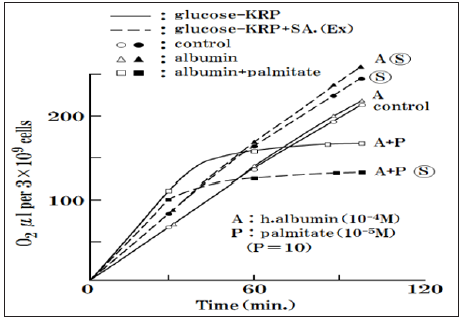
Ⓢ is a herbal medicine (SA), and combining it with Albumin (A) and Palmitic Acid (P) has been proven to stop oxygen respiration in cancer cells (Ehrlich’s ascites tumor cells) and rapidly suppress proliferation. In addition, if inflammatory changes were observed, Minomycin (50mg) with antioxidant effects was utilized in small doses. For the differentiation-inducing treatment used in this study, Vitamin A (5x104 units), high-dose Vitamin C(20-70g), Solcoseryl (2A) (SS-094) [18] and cyclic AMP (Bucladesine Sodium 300mg/1day) [15] were administered without hyperthermia therapy.
a) Case 1: This 32-year-old female patient had undergone surgery for cervical cancer. The patient experienced cancer recurrence within 3 months and was advised to undergo another surgery. However, the patient did not trust the recommendation and hence, visited our institution. The patient’s data were as follows: Tumor Marker Screening (TMCA) [19,20] showed SCC of 1.0ng/ ml, however, SLX was 48U/ml and thymidine kinase was 11.1U/ ml, which were slightly higher than normal range, Vitamin D was 126ng/ml and lower, and Vitamin A was 136ng/ml and lower. The number of T cell was 1092, stimulation index was even lower at 50.4 and number of NK cells was also too low at 17%. Ascribed to these abnormally low values, herpes zoster viral infection was confirmed. Treatment: 1 tablet of Chocola A at 10,000 units was administered three times daily, and 1 tablet of Vitamin D was administered. Herpes zoster was treated with 1g of high-dose Vitamin C every 3h at least 6 times a day. The treatment course was as follows. Based on the treatment course, there was a gradual improvement in the hematological parameters and cancer recurrences were suppressed. Although there was gradual improvement in the concentration of Vitamin A because it has differentiating activity, the concentration of Vitamin D did not improve. Maintaining the concentration of Vitamin A (target concentration of 400ng/ml) and Vitamin D (target concentration over 25ng/ml) in the blood is considered to be important (Table 1).
Table 1:
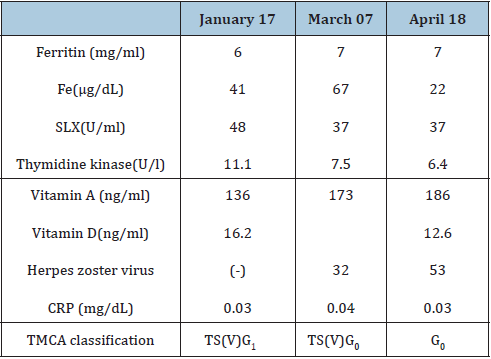
b) Case 2: This 75-year-old female patient was pathologically diagnosed with eosinophilic granulomatosis with ployangiitis. Because the patient’s condition was considerably severe, not only Vitamin A, Vitamin C, and Vitamin D, but also herbal medicine (SA) was prescribed. Because the urinary concentration of BMG rapidly increased for the first time, the involvement of inflammation was considered. From November 26, minomycin at 50mg once daily was given and after initiation of re-differentiation inducing treatment (combination of Vitamin A and high dose Vitamin C at 20g, Solcoseryl (2A) and 300mg of cAMP), the course was uneventful and getting better (Table 2).
Table 2:
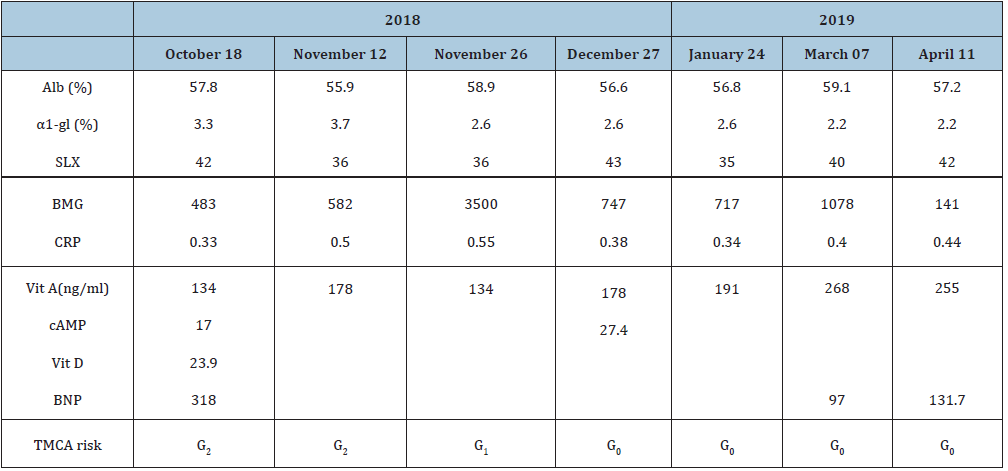
c) Case 3: This 76-year-old male with lung cancer visited our institution after refusing to undergo postoperative chemotherapy. The prescribed treatment course included herbal medicine (SA: 1.5g/day), Vitamin A (30,000 units/day), Vitamin D (0.25μg/day) and high dose Vitamin C (8g/day). Due to the disease severity, wherein decreased concentration of albumin was observed on September 6 that deteriorated to strong albumin depletion on October 23, five vials of albumin (albuminate, 25%, 50ml: CSL. Behring) were administered to improve protein fractionation. From October 8, 1 tablet of minomycin at 50mg/day was administered to reduce inflammation. The hematological parameters normalized and an improvement was observed after maintenance of relatively high concentrations of Vitamin A, D and cAMP (Table 3).
Table 3:

d) Case 4: This was a 32-year-old patient with early stage breast cancer. She took Ti Chi, but we prescribed her Vitamin A (30000 units/day) and high dose Vitamin C (8g/day) and Vitamin D(0.25μg/day). According to the increase of Vitamin A, Vitamin D and cAMP, TMCA risk assessment is getting better. Concentrations of α1-gl fraction, CA15-3, serum iron, Vitamin A, D and cAMP all of them are gradually improved. The breast tumor is now no palpable. However, FT/Fe did not improve (Table 4).
Table 4:
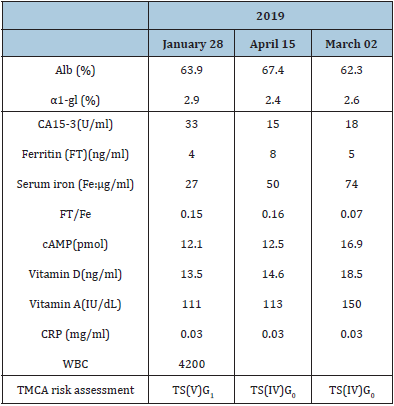
e) Case 5: After surgery for rectal cancer, the risk level of the patient was TS(V): G1. The patient father previously died from recurring rectal cancer, hence, the patient wanted to prevent cancer recurrence. (?): the possibility of different examination method was carried out? Because the concentration of Vitamin A increased, improvement in the concentrations of thymidine kinase, hyaluronic acid was observed. Vitamin D concentration is stubbornly low level, but the cancer risk classification was determined to continue improving (Table 5).
Table 5:

f) Case 6: This was a 70-year-old male patient who suffered from metastasis to liver from pancreatic cancer after pancreatic cancer surgery. After pancreatic surgery, cancer was metastasized to the liver and he presented in my clinic. At first of his treatment, Vitamin A and D are getting to increase, but on the day 13 May, the data became weak-kneed and jaundice was appeared and PTCD was set up so as to sweep out bile acid into intestinal canal. The most important fact was weak-kneed after the reduction of Vitamin A and D (Table 6).
Table 6:
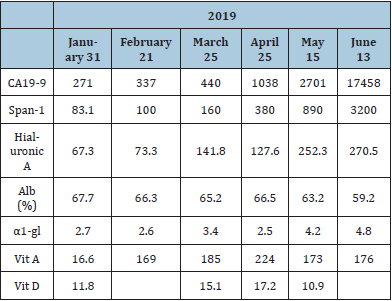
g) Case 7: 70-year-old male prostate cancer without effect of chemotherapy. This patient is getting worse when Vitamin A is decreasing. When WBC is decreasing, 3400/mm3, this patient was suffered from latent herpes zoster on the day 13/June. From this chance, PSA and γ-semino are increasing suddenly. Anyway, Vitamin A is getting decrease (Table 7).
Table 7:
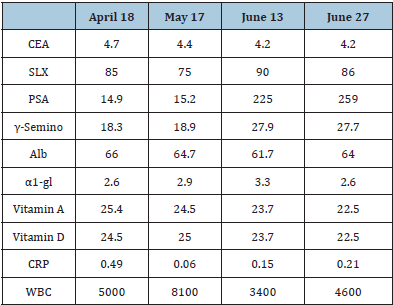
Conclusion
Cancer treatment is considered successful if DER and host factors, such as sufficient supplementation of Vitamin A, C, and D, increased concentration of cyclic AMP, and appropriate WBCs are taken into consideration. Improvements in these seven host factors are important for predicting and preventing cancer. This method is also useful for preventing cancer as evidenced by the treatment results in the five patients as described above. In the case of reduction of Vitamin A and D, cancer processing getting worse.
Discussion
Although attempts were made to predict and prevent cancer in
over 20,000 patients, since the differences in awareness between
cancer medicine based on diagnostic imaging and pathologic
diagnosis which are adhering to neoplasm shape and cancer
prediction and prevention efforts that focus on host factors are
substantial by utilizing biochemical TMCA examination. In this
study, five patients with risky clinical cancers were subjected to our
combinational treatment was followed by TMCA (tumor marker
screening). During the treatment, the concentrations of Vitamin A,
C and D in the blood were found to play an important role in the
course of treatment.
Successful treatment was evidenced by an increased
concentration of cyclic AMP. We confirmed the process by which
immunity increases and treatment is considered successful. To date,
cancer medicine has excessively relied on the diagnostic imaging
and pathological diagnosis. Nevertheless, the host factors, DER,
improvements in the blood concentrations of Vitamin A, C, and D
and cyclic AMP, which were undervalued in the medical treatment
of carcinoma until recently, were proven to be important in the
path to successful treatment. If cancer prediction and prevention
methods can be performed in more patients in the future, there
will be further understandings of the importance of host factors in
cancer prediction and prevention. With the emergence of Opdivo
in the field of cancer medicine, the aspect of immunity has been
increasingly receiving attention; however, the hope is that there will
also be interest in the internal host factors in the body. The reduction
of those people who are suffering from cancer is dependent upon
not only neoplasm shape but also host factors. High dose of Vitamin
A, C and D has no side effects at all in cancer patients.
References
- Smith JE, Muto Y, Milch PO, Goodman DS (1973) The effects of chylomicron Vitamin a on the metabolism of retinol binding protein in the rat. J Biol Chem 248(5): 1544-1549.
- Muto Y, Moriwaki H, M Ninomiya, Adachi S, Saito A, et al. (1996) Prevention of second primary tumors by an acyclic retinoid, polyprenoic acid in patients with hepatocellular carcinoma. N Engl J Med 334(24): 1561-1567.
- Muto Y, Smith JE, Milch PO, Goodman DS (1972) Regulation of retinol-binding protein metabolism by Vitamin A status in the Rat. J Biol Chem 247(8): 2542-2550.
- Seyfried TN (2011) Mitochondrial glutamine fermentation enhances ATP synthesis in murine glioblastoma cells. Proceeding of the 102nd Annual Meeting of the American Association of Cancer Research 71(8): 985.
- Seyfried TN, Shelton LM (2010) Cancer as a metabolic disease. Nutr Metab 7: 7.
- Appleton BS, Campbell TC (1982) Inhibition of aflatoxin-inhibited preneoplastic liver lesions by low dietary protein. Nutri Cancer 3(4): 200-206.
- Dunaif GE, Campbell TC (1987) Dietary protein level and aflatoxin B1-induced preneoplastic hepatic lesions in the rat. J Nutri 117(7): 1298-1302.
- Chen Q, Espey MG, Krishima MC, Mitchell JB, Corpe CP, et al. (2005) Pharmacologic ascorbic acid concentrations selectively kill cancer cells: Action as pro-drug to deliver hydrogen peroxide to tissues. Proc Natl Acad Sci USA 102(38): 13604-13609.
- Chen Q, Espey MG, Sun AY, Lee JH, Krishna MC et al. (2005) Ascorbate in pharmacologic concentrations selectively generates ascorbate radical and hydrogen peroxide in extracellular fluid In vivo. Proc Natl Acad Sci USA 104(21): 8749-8754.
- Ingraham BA, Bragdon B, Nohe A (2008) Molecular basis of the potential of Vitamin D to prevent cancer. Current Medical Research and Opinion 24(1): 139-149.
- Buyru N, Tezol A, Yosunka FE, Dalay N (2003) Vitmain D receptor gene polymorphisms in breast cancer. Experimental & Molecular Medicine 35(6): 550-555.
- Garland CF, Garland FC, Gorham ED, Lipkin M, Newmark H, et al. (2006) The role of Vitamin D in cancer prevention. American Journal of Public Health 96(2): 252-261.
- Tsuneo K (2018) Biochemical meaning of defective immune surveillance in cancer patients. Arch Cancer Res 6(2): 8.
- Hsie AW, Puck TT (1971) Morphological transformation of Chinese hamster cells by dibutyryl adenosine cyclic 3’: 5’-monophosphate and testosterone. Proc Natl Acad Sci USA 68(2): 358-361.
- Tsuneo K (2019) Re-differentiation inducing treatment for cancer. Journal of Cancer Science and Therapy 1(16): 1-19.
- Sugimoto K, Jo T, Tanimizu T (1982) The effect of the anti-tumor herb medicine “Sun Advance” in mice. Proc Symposium Wakanyaku 15: 224-227.
- Tanimizu T, Sugimoto K, Hayashi N (1982) New approach to Chinese herb medicine, inhibition by Chinese herb medicine ”Sun Advance” of SV40 transformation in mouse cells. Proc Symposium Wakanyaku 15: 228-233.
- Ueda M, Akita S, Torii S, Kaneda T, Oka T (1981) Effects of solcoseryl on flap survival. Nagoya J Med Sci 44(1-2): 23-30.
- Kobayashi T, Kawakubo T (1994) Prospective investigation of tumor markers and risk assessment in early cancer screening. Cancer 7(7): 1946-1953.
- Tsuneo K (2018) A blood tumor marker combination assay produces high sensitivity and high specificity for cancer according to the natural history. Cancer Medicine 7(3): 549-556.
© 2020 Tsuneo Kobayashi. This is an open access article distributed under the terms of the Creative Commons Attribution License , which permits unrestricted use, distribution, and build upon your work non-commercially.
 a Creative Commons Attribution 4.0 International License. Based on a work at www.crimsonpublishers.com.
Best viewed in
a Creative Commons Attribution 4.0 International License. Based on a work at www.crimsonpublishers.com.
Best viewed in 







.jpg)






























 Editorial Board Registrations
Editorial Board Registrations Submit your Article
Submit your Article Refer a Friend
Refer a Friend Advertise With Us
Advertise With Us
.jpg)






.jpg)














.bmp)
.jpg)
.png)
.jpg)










.jpg)






.png)

.png)



.png)






